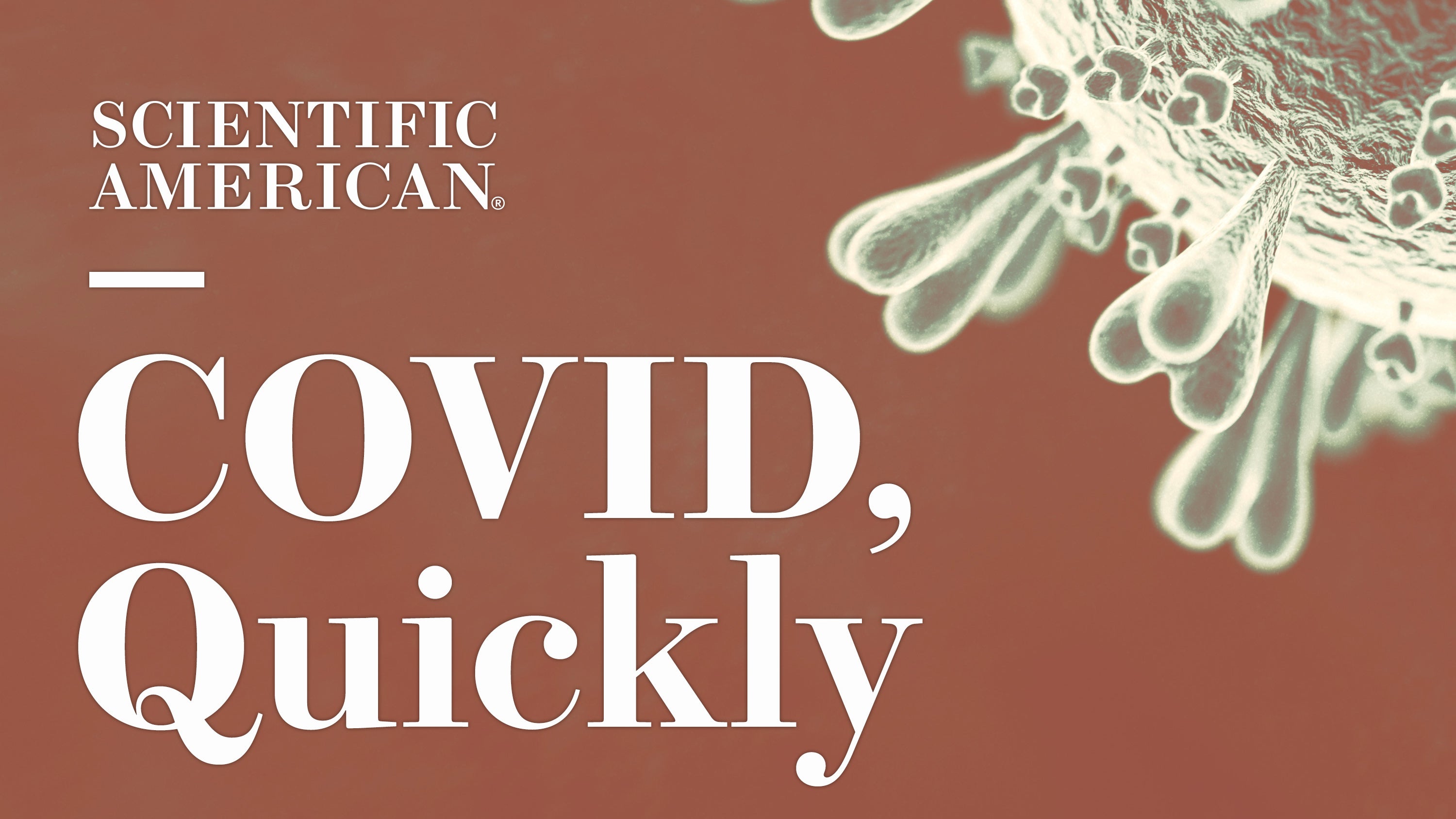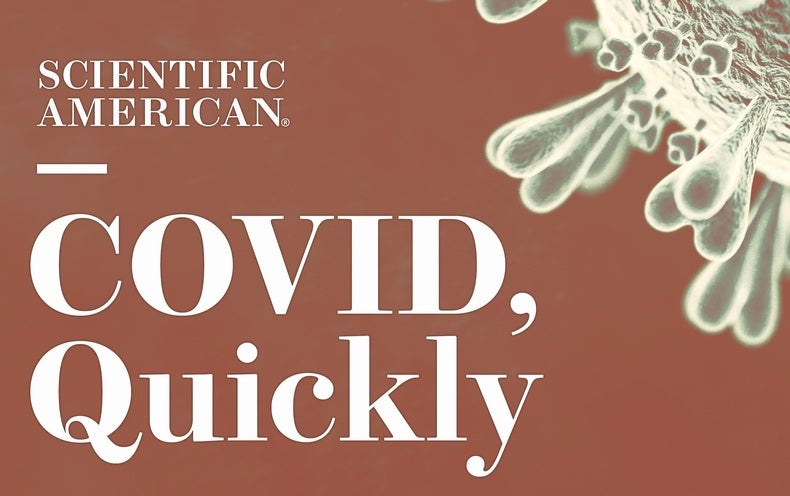
Tanya Lewis: Hi, and welcome to COVID, Quickly, a Scientific American podcast series.
Josh Fischman: This is your fast-track update on the COVID pandemic. We bring you up to speed on the science behind the most urgent questions about the virus and the disease. We demystify the research and help you understand what it really means.
Lewis: I’m Tanya Lewis.
Fischman: I’m Josh Fischman.
Lewis: And we’re Scientific American’s senior health editors. Today: how to care for yourself when you’re sick at home with COVID…
Fischman: And how do you know when it’s just spring allergies making you sneeze, and not the virus?
—
Lewis: These days I keep hearing about people getting COVID and riding it out at home. If you have a relatively mild case, what should you do to take care of yourself?
Fischman: More and more people are in exactly that situation. The daily average of new cases has been going up, from about 50,000 at the end of April to just over 80,000 today. But a lot fewer people are ending up in the hospital. Just under 20,000 at the end of last week.
Lewis: That means more people with COVID are taking care of themselves at home, doesn’t it?
Fischman: Yep. So what’s the best way to do that? What helps with symptoms? How do you handle isolation? I asked Scientific American contributing editor Lydia Denworth to look into that. She spoke with several doctors who treat COVID and came up with some good tips.
Lewis: Even though we call these mild cases, people say it’s often like two weeks of the worst flu you can imagine, with fevers and racking coughs.
Fischman: True. So first of all, note your symptoms. Timothy Brewer, an epidemiologist at UCLA, told Lydia there’s a wide range but a lot of them hit your upper respiratory system. That’s where Omicron and its sub-variants like to replicate. So there’s less chest and lung inflammation and more sore throats and congestion. Achiness, coughing, shortness of breath and fever are also common.
Lewis: I’d probably want to test myself if I started feeling bad. Should I use a rapid antigen test?
Fischman: Definitely. These symptoms can look like bad allergies or the flu, so experts say use an antigen test after symptoms start. If the first test is negative, do another two days later. If the virus is building up inside you, the second test will probably pick it up.
Lewis: OK, so I’m positive and feel positively awful. Time to call my doctor?
Fischman: Not everyone has a primary care doc but call yours if you do. They can advise you on medications. They’ll also notify public health agencies so you’re included in case counts.
Lewis: After that, is there anything in my medicine cabinet that can help me?
Fischman: Probably, or over-the-counter at your local drug store. Common drugs don’t fight the virus but they do manage symptoms. Acetaminophen brings down fevers and relieves achiness. So do nonsteroidal anti-inflammatory drugs (NSAIDs), like ibuprofen. Antihistamines or cold medications such as DayQuil relieve congestion and cough.
Lewis: People should be careful with NSAIDs, though. They have more side effects than acetaminophen, and they’re not safe for everyone. I know the label instructions are in tiny print, but it’s a good idea to read them. You should probably check with your doctor if you’re taking other drugs, too.
Fischman: Sometimes I take a picture of the label with my cell phone and blow it up. That helps.
Another thing that helps a lot: good old TLC. Rest, and drink fluids, which prevent dehydration and reduce cough. Hot tea with honey alleviates sore throat and cough, too.
Lewis: What about prescription drugs like the new antiviral pill, Paxlovid?
Fischman: That helps if you start taking it early. But its not for everyone. You can’t use it with many common medications such as statins or blood thinners. Some monoclonal antibodies also reduce the risk of severe disease, but they require an injection or infusion. And not every patient is eligible. Both treatments have been authorized for people who are at higher risk of severe illness because of age (65 and older) or underlying health conditions such as high blood pressure or lung disease. There’s no evidence yet that these treatments benefit people who are young or otherwise healthy.
Lewis: What happens if you live by yourself? Lots of people do, some of them young and some older. Being alone with COVID can be scary.
Fischman: I know, and if you don’t have a partner to make drug store runs and food runs, it’s really tough. Brewer says it’s smart to arrange to have someone call you once a day to check up. The check-ins can reduce anxiety and loneliness, because you’re isolating for at least five days. Friends and family shouldn’t get physically close, but they can drop off meals, or Tylenol and other OTC medications. And some books, magazines, or TV show recs to fill the hours.
Lewis: So you do this for 5 days after symptoms start and a positive test. Then if you feel better you can go out but should wear a high quality mask like an N95, and do that for another 5 days. That’s 10 days total. Are there warning signs in that period that could lead you to call for medical help?
Fischman: Excellent question. Doctors told Lydia the big thing to watch for is serious trouble breathing. Chest pain, blue lips, if you can’t swallow liquids, or get winded after taking a few steps in your bedroom–all reasons to get over to urgent care or call 911. Most people won’t run into this kind of trouble, but do not be shy about reaching out for help if you do.
—
Lewis: Josh, it’s been a rough allergy season. I find myself sniffling and sneezing constantly, and have gone through more tissue boxes than I care to admit. But given all the COVID swirling around, I’m constantly paranoid that the virus has finally found me. Of course, the only way to know for sure whether you have COVID is a positive test. But tests aren’t always available, and it can take days to test positive on a rapid test even if you already have symptoms.
Fischman: It does seem to be a rough allergy season. How can you tell the difference between COVID and allergies?
Lewis: Actually, freelance contributor Mariana Lenharo asked experts this very question for a story we published recently. The symptoms are pretty similar: nasal congestion, runny nose, sore throat, sneezing, coughing, headaches and fatigue. But there are some pretty key differences.
Fischman: Fever is one of them, right?
Lewis: It’s not a common feature of allergies, so that’s one giveaway. Another is sudden and severe smell loss. This was a common feature with earlier variants of the coronavirus, but is less common with Omicron. Still, allergies are unlikely to cause complete smell loss. And watery, puffy eyes are common with allergies but less so with COVID.
Fischman: That’s helpful. So, if I have a fever or other symptoms less common with allergies, should I take a COVID test?
Lewis: Yes. Thinking about your own body and the context in which you started having symptoms is also important. Like, if you just mowed the lawn and started sneezing, it’s probably allergies. But if you recently attended an indoor event with 200 people talking loudly, it could be COVID.
Fischman: Do we know anything about whether people who have allergies are more susceptible to COVID?
Lewis: At first, scientists were worried that people who have allergic asthma were more likely to get COVID and have a severe case—something that can happen with the flu. But a study published in the journal Thorax found the opposite—that people with allergic asthma may be at a lower risk of COVID than other people. Some studies show that people with allergic asthma appear to have lower levels of a receptor for the COVID-causing virus.
Fischman: That’s good news. Is there anything we can do to protect ourselves against both COVID and allergies?
Lewis: Wear a mask! It might spare you some sniffles—or worse.
—
Lewis: Now you’re up to speed. Thanks for joining us. Our show is edited by Tulika Bose.
Fischman: Come back in two weeks for the next episode of COVID, Quickly! And check out SciAm.com for updated and in-depth COVID news.
[The above text is a transcript of this podcast.]

